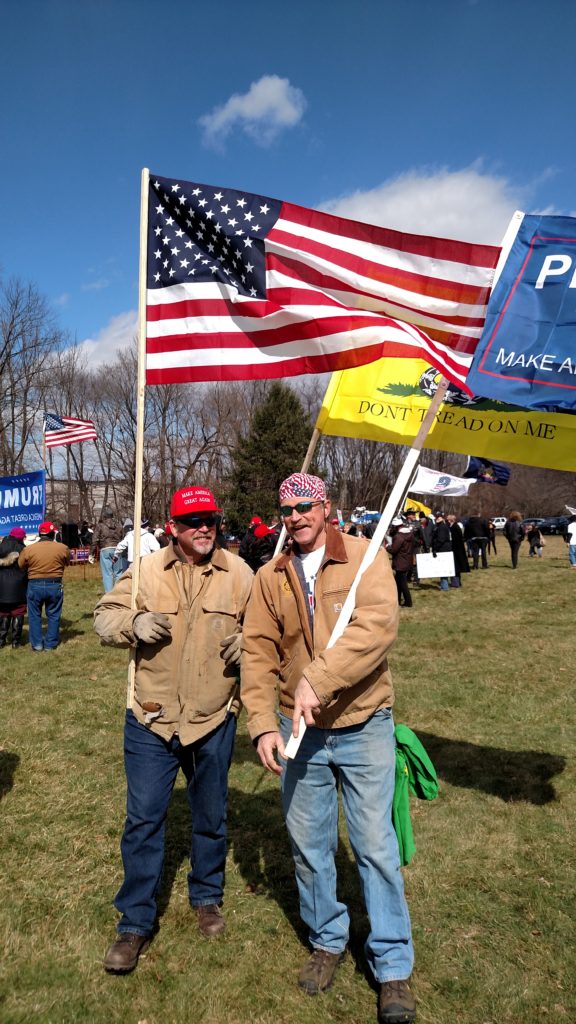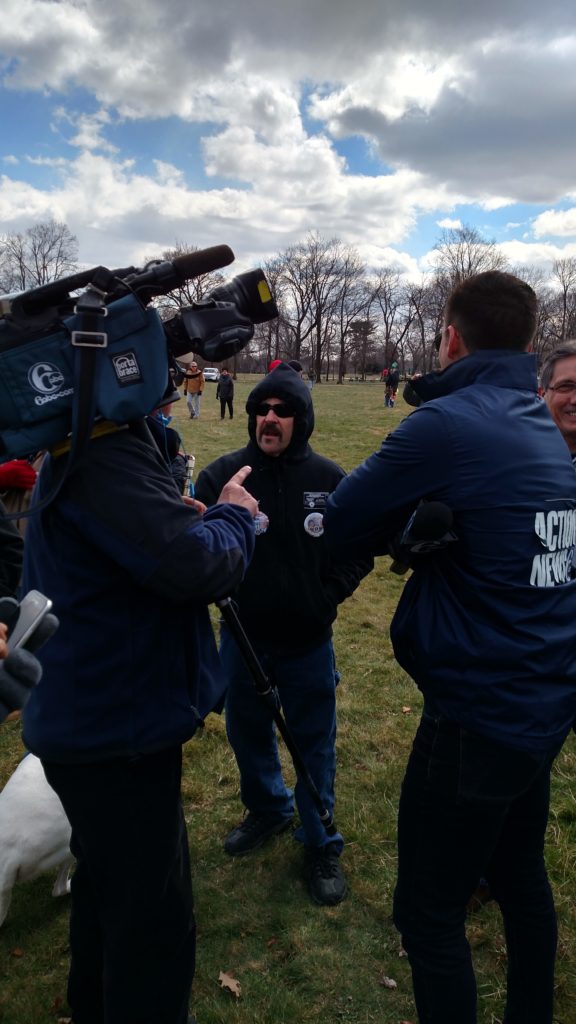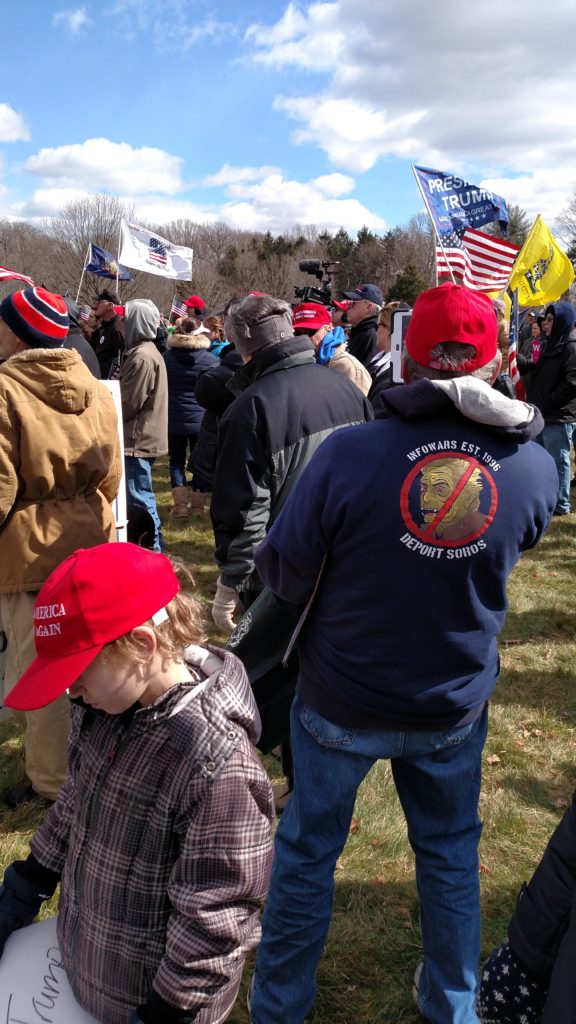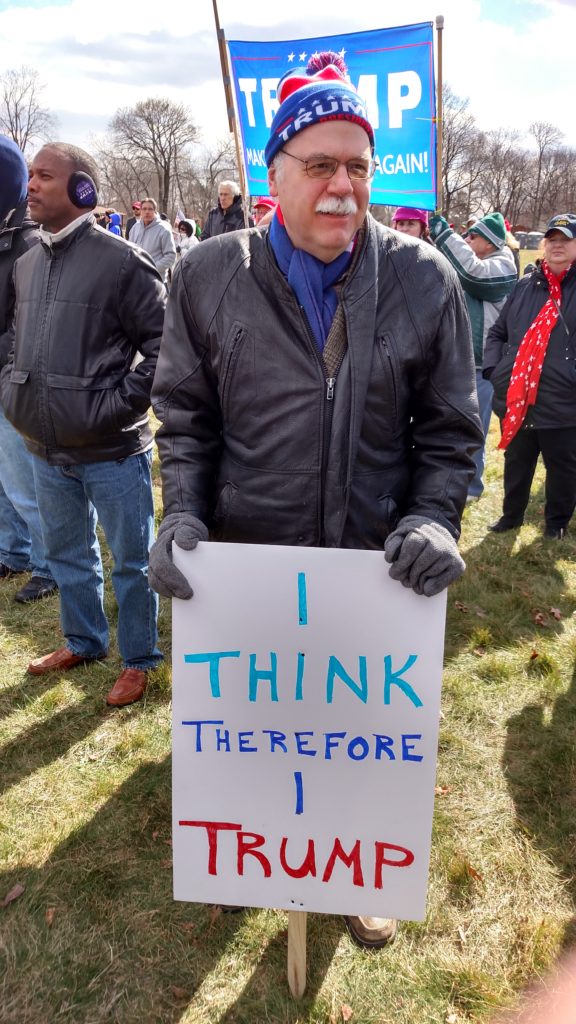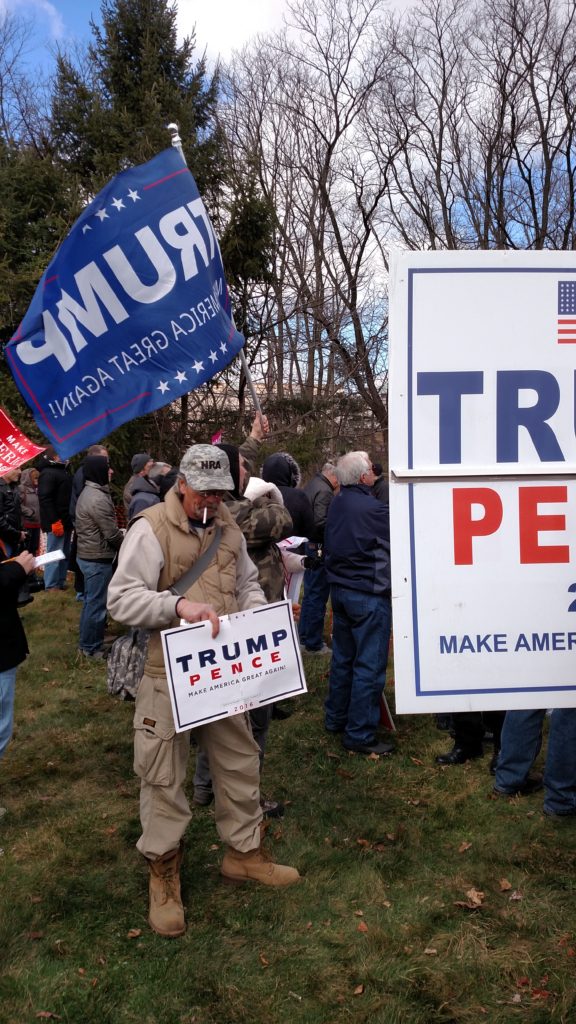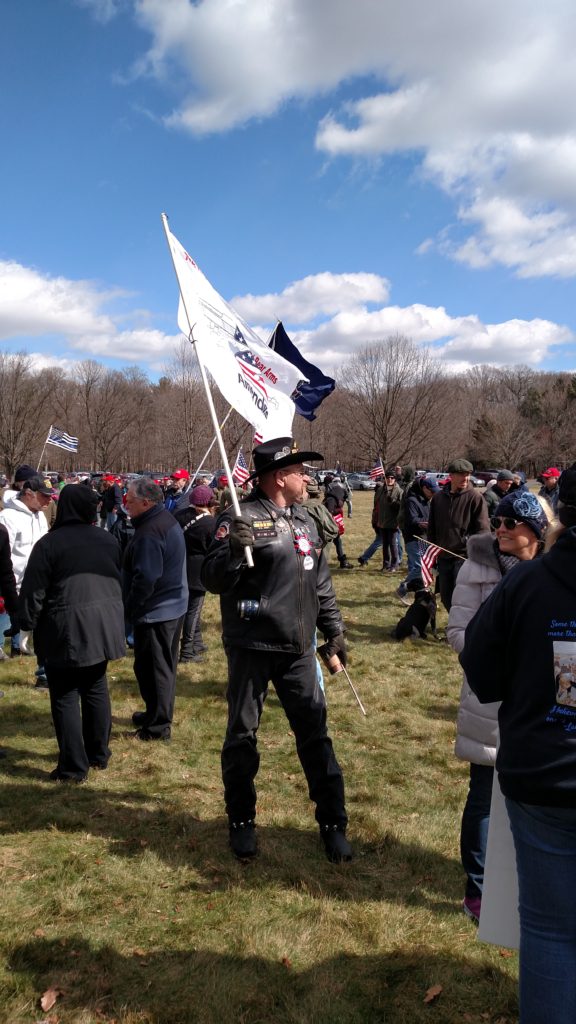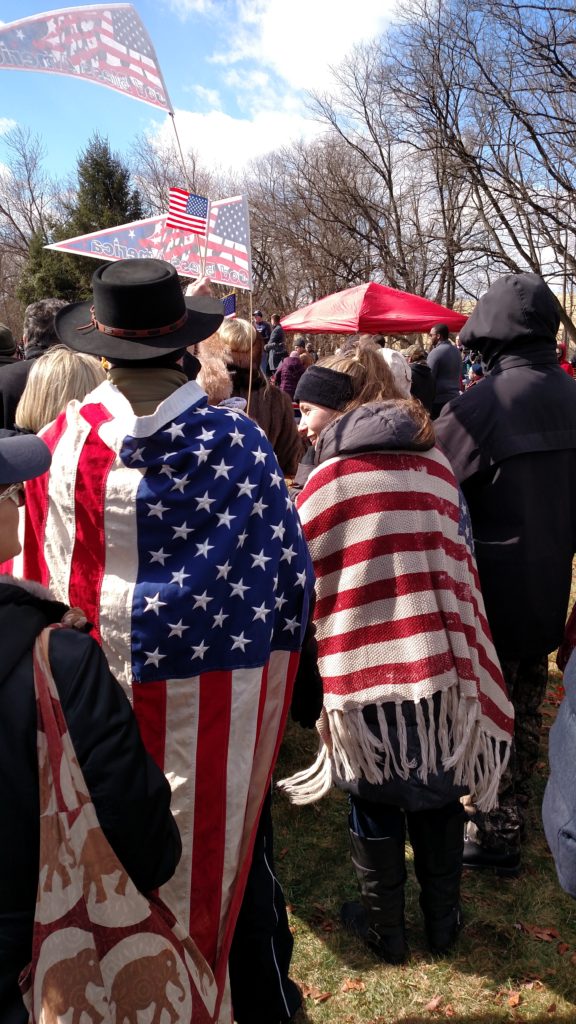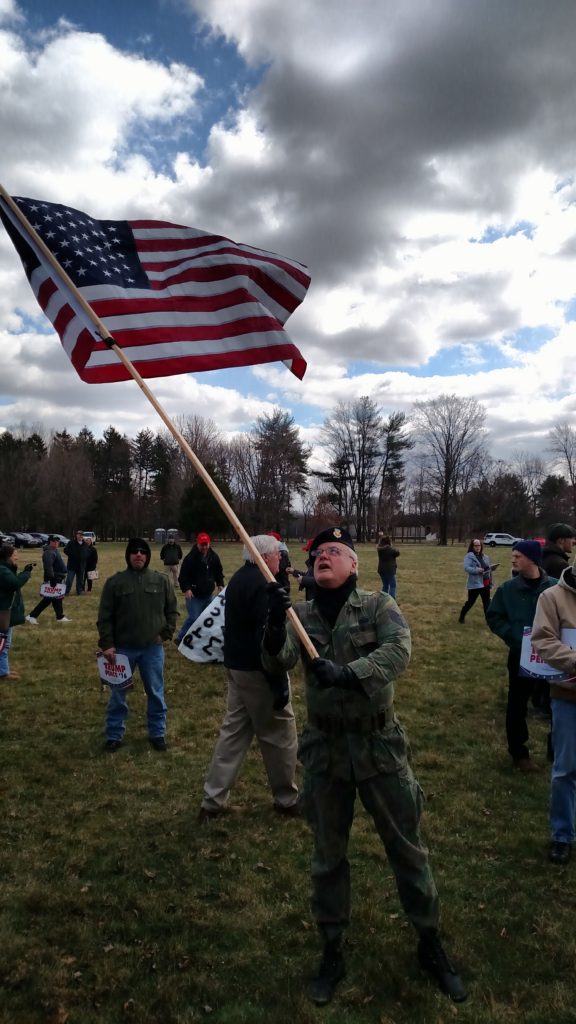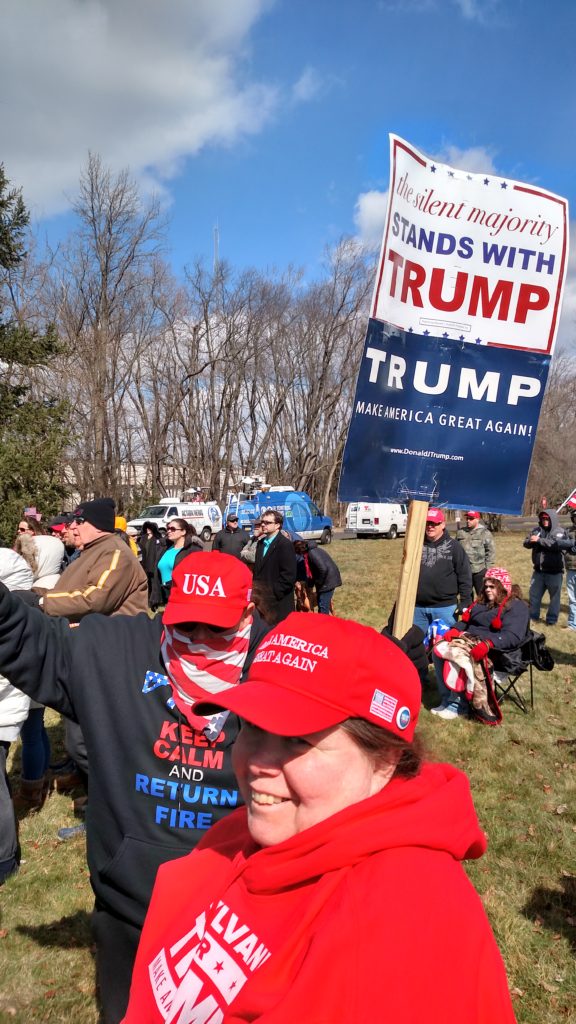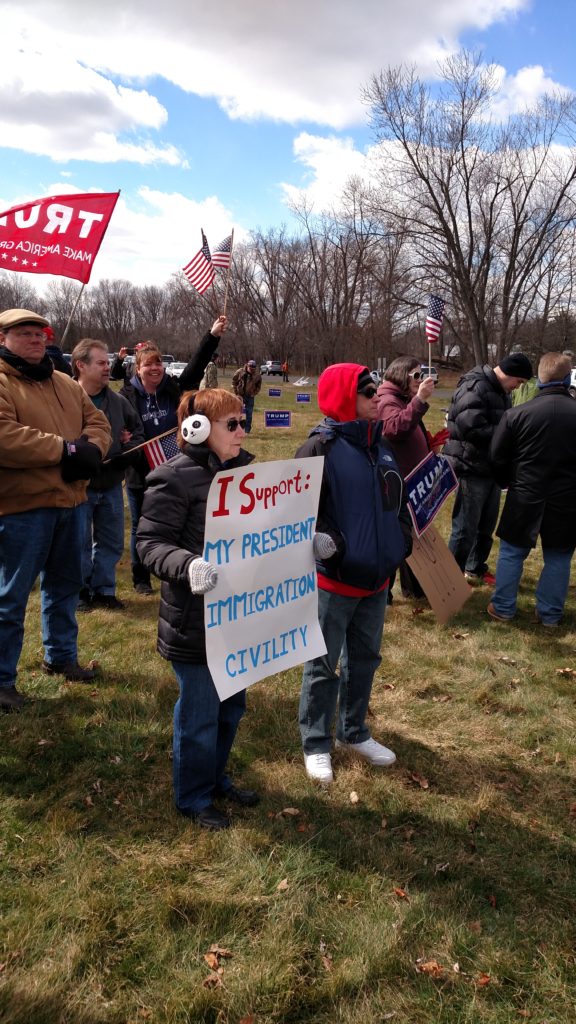In the Godforsaken Wilderness
Sound and Fury on the Delaware
In the Godforsaken Wilderness is a blog by Patrick Blanchfield being published in the wake of the 2016 presidential election.

By Patrick Blanchfield
A bitter wind is coming off the Delaware River, and the Trump supporters at the rally in Neshaminy State Park are growing restive. We’re in Bucks County, Pennsylvania, right across the river from Jersey, not far from Levittown and Trenton, it’s below freezing, and the People 4 Trump “Spirit of America” rally is starting fifteen minutes late. A crowd of some five hundred people stamp feet in the cold, rub mittens together, and drag on coffee and cigarettes. Finally, on the stage at the center of the lawn, someone gets a sound system working and starts playing music. It’s Toby Keith’s “Courtesy of the Red, White, and Blue (The Angry American)” and soon people are hollering and belting out the lyrics together.
Justice will be served and the battle will rage
This big dog will fight when you rattle his cage
And you’ll be sorry that you messed with
The U.S. of A.
‘Cause we’ll put a boot in your ass
It’s the American way
It’s early March, Trump’s been in office for only a little more than a month, and here in Southeastern Pennsylvania, supporters have gathered to rally in support of a sitting President. The event website promised a “sign waving rally [that] will be peaceful, positive, patriotic, uplifting, and open to anyone that supports an America First agenda.” At least as far as the signage goes, the participants have delivered, bringing hundreds of flags and hand-painted cardboard signs and banners.
The crowd itself is full of middle-aged and older men, bikers in leather outfits, dudes in camo hunting gear, men in work clothes. But there are dozens of families, toddlers in Trump gear, and a not-inconsiderable number of women carrying tiny dogs in their arms and purses. The cars in the lot are all sorts – not just pickups, minivans, and SUVs, but more than a few luxury cars too. The organizers have proclaimed that “unlike those protesting against President Trump’s vision, we are a diverse coalition that are the heart and soul of America that wants our nation to fulfill our potential, as the greatest nation on God’s green earth!” Practically speaking, though, the sea of faces is overwhelmingly white. I count maybe two-dozen people who might be Latino, and fewer still Black people. In fact, there are more Black folks on the stage in front of the cameras than there are in the crowd itself.
After a song and a prayer, the event gets underway in earnest. The organizer, Jim Worthington, is a local businessman, the owner of an athletic club who spent some $30,000 campaigning for Trump and went as a delegate to the Republican National Convention. He’s lean and photogenic, and gets visibly emotional talking about Trump, a “great man,” and the “movement” this rally represents. He’s also relentless in extolling “positivity,” telling everyone in the audience that we should appreciate the media: “We’re grateful they came out in the cold to the cover this, we should thank them.”
Meanwhile, while Worthington speaks, a man in a black hoodie and sunglasses roams the crowd, confronting people he believes to be journalists, demanding “Are you fake news?” He shoulders into an interview being conducted by a TV correspondent and a cameraman, and asks, “Who are you with?” The reporter says he’s with a local TV affiliate, but that doesn’t satisfy the man. “That’s not good enough, that doesn’t mean anything, you could be fake news.” The reporter tries to turn around and resume to his interview, but the man isn’t having it, cutting in front of him and starting to get handsy, jabbing his fingers at the reporter’s chest and throat. “Are you fake? Are you fake news, man?” The reporter and his cameraman abandon their interview attempt and walk away, the man in the hoodie following them, only getting angrier and louder. Later, I see him berating another cameraman – this time, one wearing a Trump Make America Great Again hat in addition to his press badge. But that doesn’t stop the questions. “Who are you with? Are you fake?”
Disjunctions like these keep piling up. Worthington’s followed by the emcee, a woman who was a former contestant on the Apprentice (“I was on a little show … maybe you’ve heard of it …”) who receives tepid recognition when she compliments everyone on their civic engagement and eagerness to contribute to a new phase of the “movement.” Then another speaker gets up and promptly launches into a tirade that I find hard to follow, but that the audience loves. He starts by bringing up recent controversy over the nomination of Jeff Sessions as attorney general, which he paints as a “fake news” misdirection. “The moment Trump announced Sessions,” he says, “They [the Democrats] went after him. What are they trying to hide?” Someone in the crowd yells “Pizzagate!” but he keeps going – the real story is how Hillary “sold uranium to the Russians.” Next he’s on to condemning Philadelphia Democrats and sympathizing with the “good people who moved out” following various outrages. He mentions “that time the Democratic Mayor blew up a whole block in West Philly,” alluding to the MOVE bombing, and then in the next breath accuses city Democrats of “being soft on ISIS,” and introducing an unacceptable soda tax. The crowd loves all of this – some yell “Lock her up!” and others start to chant “Trump! Trump! Trump!” in rapid cadence. Everyone has gotten the memo about being “positive and uplifting” but their actual enthusiasm seems to lie elsewhere.
On the stage, Worthington takes over again, congratulating the crowd on its “diversity” and recognition of how “the time has come to work together, to celebrate difference, to embrace the other side.” There’s no room for hate or “divisiveness,” he continues, as the cameras focuses in on his perfect hair and manicured features. Meanwhile, only feet away, another man walks around taking pictures and chatting people up. He’s wearing a jacket with “Infowars, Est. 1996” printed on across the black shoulders. Below that logo is a caricatured face of a green-skinned old man with a hooked nose, beady red eyes, and sharp vampire teeth complete with dripping blood; a caption beneath the cartoon reads “Deport Soros.” It’s like Count Dracula meets the Jud Süß, a cartoon that feels like it’s ripped from the pages of Der Stürmer.
I admit I have a hard time processing all this. Anodyne pap about tolerance and democratic participation unfolds seamlessly alongside barely contained rage and images of bigotry so galling they almost don’t seem real, and which no one apparently feels any need to conceal.
And then, with a few parting words of further congratulation and pride from Worthington, the event suddenly ends, fifteen minutes early. We walk back to our cars as the Rolling Stones’ “You Can’t Always Get What You Want” plays on the sound system.
Waiting to leave the jammed parking lot takes almost as long as the event itself. Idling in the car alongside scores of others, fumes rising from exhaust pipes and cigarette smoke from cracked windows, I find myself wondering – what was the purpose of this event? From the music playlist to the speakers’ rhetoric, it felt like a kind of exercise in repetition, a sort of hollow reprise of a campaign event. But, of course, Trump wasn’t here, he’s already won. And so here these people were, listening to a speaker break down in tears telling the story of how he met Trump visiting a hospital (“such a great man”), and yelling about how Democrats are “thugs,” all as though trying to recapture some sort of long-gone glow. I kept looking for some kind of collective effervescence on the field, but I couldn’t feel any of it. People seemed ardent, sure, but never particularly joyous; if anything, the unifying emotion seemed to be loneliness itself, a force that brought everyone together while still leaving them somehow apart.
I finally get out of the parking lot, pulling past a crude roadside memorial to someone apparently killed in a car crash. Then it’s on to the state road and the highway, passing vacant industrial parks, moldering factories, boarded-up row homes, and stripmall after stripmall. The roadside billboards are like a catalogue of bleakness: treatment centers for painkiller addiction; an alert with mugshots of two brown men wanted for a bank robbery; recruiting posters for the military; an ad for something called “Nostalgia Fest” (“Meet Gary Busey!”). And then, just past the big casino, an ad for a gambling support hotline: “If I could just win again.”
A few miles further on, as the neighborhoods get wealthier, right next to the highway, I pass a strange structure, a tower with massive vents along its bottom. It contains a special chamber into which paying customers can enter and stand in a vertical wind tunnel with fans above and beneath them. A switched is flipped, and then the fans turn on, lifting the customer into the air and suspending them there. For a little bit, the attraction promises, you’ll be able to experience what it’s like to fly.
***
In the Godforsaken Wilderness is a blog being written by Patrick Blanchfield in the wake of the 2016 presidential election. You can read past posts here.
All photographs taken by Patrick Blanchfield. Please do not reproduce without permission.
***
Patrick Blanchfield is the Henry R. Luce Initiative in Religion in International Affairs Post-Doctoral Fellow at the Center for Religion and Media at NYU. He holds a PhD in Comparative Literature from Emory University and is a graduate of the Emory University Psychoanalytic Institute. He writes about US culture, guns, and politics at carteblanchfield.com and is on Twitter as @patblanchfield.
***
Published with support from the Henry R. Luce Initiative on Religion in International Affairs.
